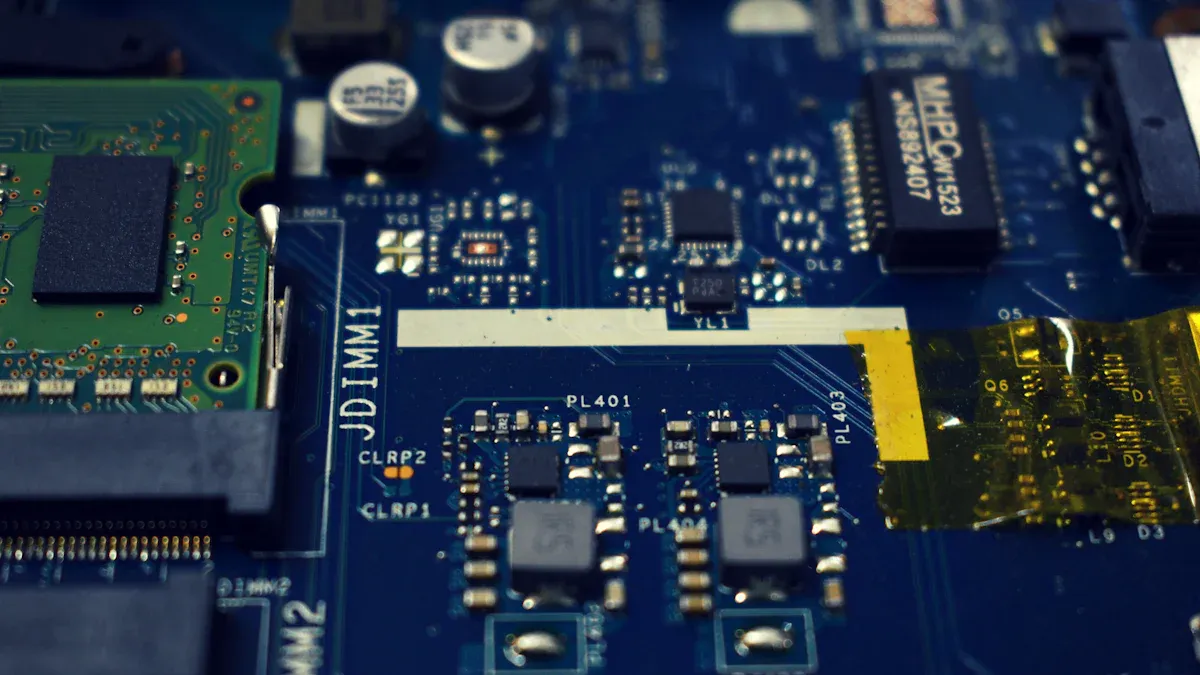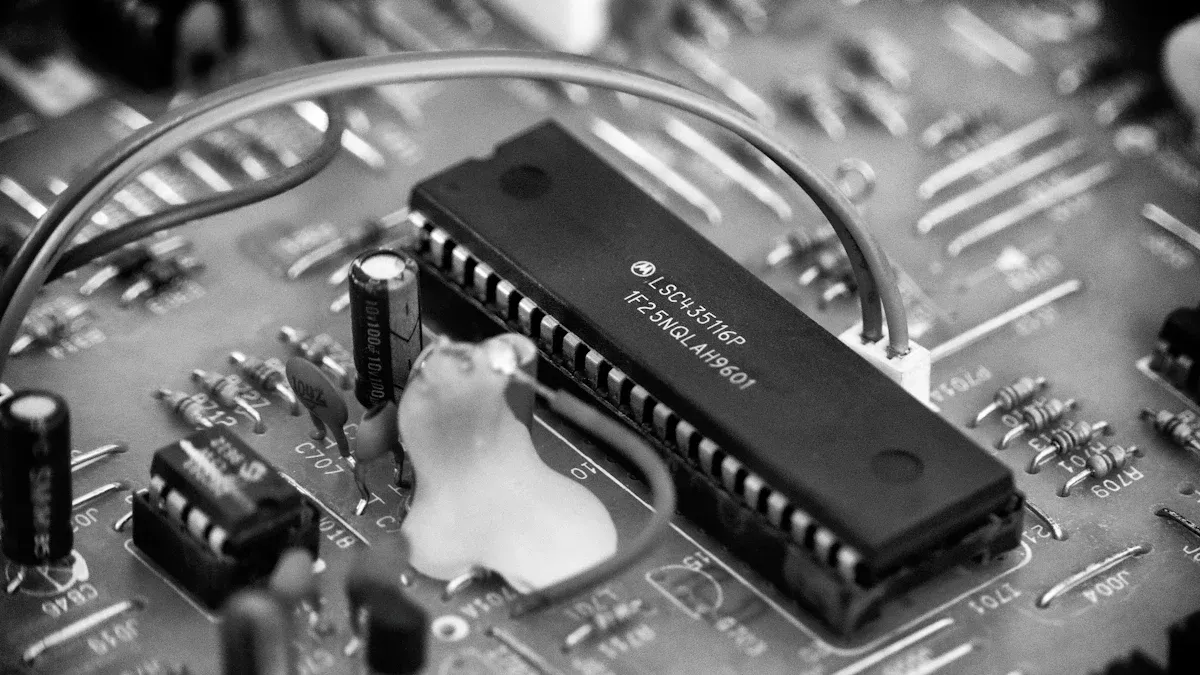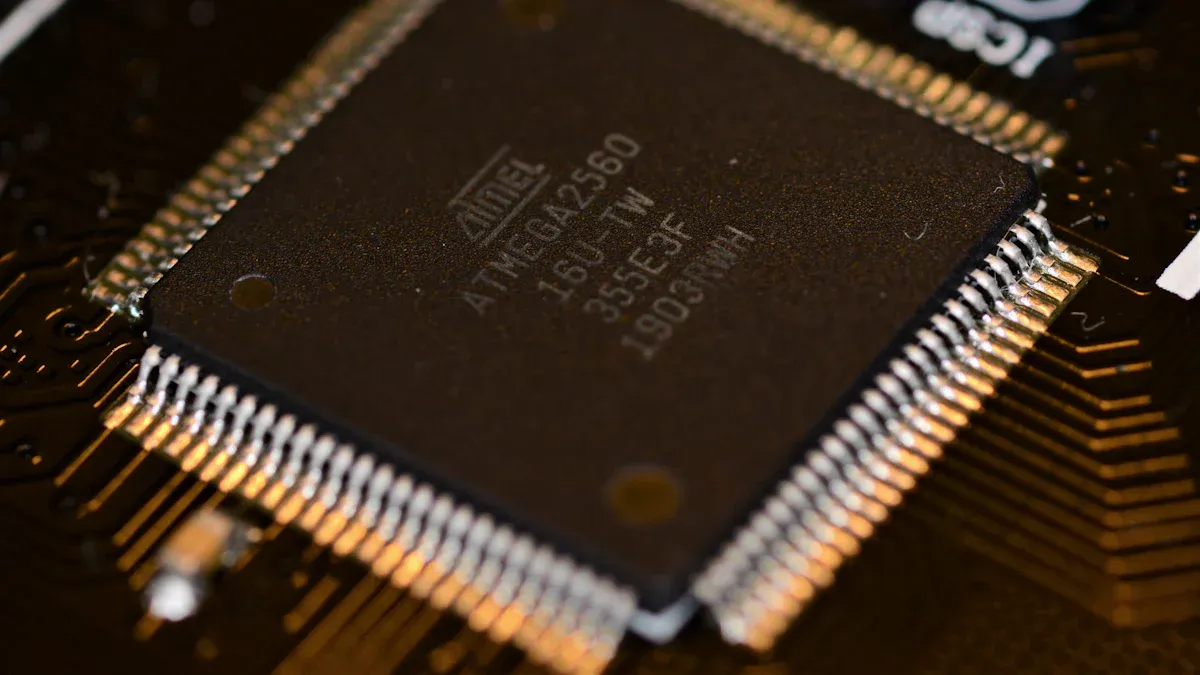What Is an LVDS Differential Driver Chip and How Does It Work

An LVDS Differential Driver chip sends digital signals using two wires that carry opposite voltages. The chip pushes a steady current of about 3.5 mA through these wires, and a resistor at the receiver end creates a small voltage difference of around 350 mV. This method allows fast and reliable data transfer, even at speeds up to 660 Mbps. Engineers use this chip because it supports low power operation and reduces noise, making it important for modern electronics.
Key Takeaways
LVDS Differential Driver chips send data fast and clearly using two wires with opposite voltages, allowing speeds up to nearly 2 Gbps.
These chips use low power by pushing a small, steady current, which reduces heat and saves energy in devices.
Differential signaling helps cancel out noise and interference, keeping data accurate even in noisy environments.
A 100-ohm resistor at the receiver end matches the wires to prevent signal errors and maintain strong communication.
LVDS chips are widely used in electronics like smartphones, cars, medical devices, and industrial systems for reliable, high-speed data transfer.
LVDS Differential Driver Chip

Definition
An LVDS Differential Driver chip is a small electronic component that sends digital signals using two wires. These wires carry opposite voltages, which helps the chip send information quickly and clearly. The chip uses a low voltage, usually around 3 volts, and works with a steady current. This design allows the chip to move data at high speeds, often up to 600 Mbps or more. Many chips follow the TIA/EIA-644 LVDS standard, which sets rules for how they should work. Some common examples include the ADN4661 and ADN4663, which use CMOS technology for better performance.
LVDS Differential Driver chips can handle high-speed data transmission. They support data rates up to 28 Gb/s in advanced designs. These chips also allow for some mismatch in wire length, up to 2.4 inches, without losing signal quality. This makes them reliable for many digital systems.
Purpose
Engineers use the LVDS Differential Driver chip to send data between different parts of a device. The chip helps keep signals strong and clear, even when wires are long or there is electrical noise nearby. It works well in point-to-point data transmission, where one chip talks directly to another. This method reduces errors and keeps data safe.
The chip also protects against static electricity, meeting strict ESD standards up to 8 kV. It uses less power than older signaling methods, making it a good choice for devices that need to save energy. Many products, such as computers, cameras, and industrial machines, use these chips to move information quickly and safely.
Specification / Feature | Details |
|---|---|
Standard Compliance | TIA/EIA-644 LVDS standard |
Data Rate Support | Up to 600 Mbps |
ESD Protection | Meets 8 kV IEC standards |
Technology | CMOS-based |
Operating Voltage | 3 V |
Key Characteristics | High speed, low power, improved noise immunity, low emissions |
Application | Point-to-point data transmission |
Product Examples | ADN4661, ADN4663, ADN4665, ADN4667 |
Advantages | Low power, robust for harsh environments |
How It Works

Differential Signaling
An LVDS Differential Driver chip uses differential signaling to send data. This method uses two wires. One wire carries a positive voltage, and the other carries a negative voltage. The difference between these voltages represents the digital signal. When the voltage on one wire goes up, the voltage on the other wire goes down. The receiver looks at the difference between the two wires, not the absolute value on each wire.
This approach helps cancel out noise. If both wires pick up the same noise from the environment, the difference stays the same. The receiver ignores the noise and reads the correct data. Engineers use differential signaling because it keeps signals clear, even in places with lots of electrical interference.
Differential signaling makes LVDS Differential Driver chips reliable for high-speed data transfer. It helps prevent errors and keeps information safe.
Current-Mode Operation
The LVDS Differential Driver chip works in current-mode. Instead of switching high voltages, the chip pushes a small, steady current—usually about 3.5 mA—through the wires. A resistor at the receiver end, often 100 ohms, turns this current into a small voltage difference, usually around 350 mV. This low voltage swing means the chip uses less power and creates less heat.
Technical experiments support this design. For example, engineers built a low voltage D-Latch using 45 nm CMOS technology. It worked at only 0.6 V and used 62% less power than older designs. The circuit kept a strong output swing and worked well at different temperatures. Other tests show that current-mode drivers can send data at very high speeds, like 112 Gbps, while using very little power. These results prove that current-mode operation and low voltage swing make LVDS Differential Driver chips fast and efficient.
Key points about current-mode operation:
Uses a small, steady current instead of high voltage.
Keeps voltage swing low, saving power.
Works well at high speeds and in different environments.
Driver and Receiver
The driver and receiver work together to keep the signal strong and clear. The driver sends the current through the two wires. The receiver sits at the other end and measures the voltage difference created by the current and the termination resistor. This setup helps prevent signal reflections, which can cause errors.
Measured data from real circuits shows how this works. Engineers use a 100-ohm resistor at the receiver to match the wires' impedance. This match stops reflections and keeps the signal clean. The receiver also uses special circuits, like failsafe biasing networks, to handle noise and faults. These networks help the receiver stay stable, even if the wires pick up extra noise or if the signal drops out for a moment.
The differential signaling method also helps the receiver ignore common-mode noise. If both wires pick up the same noise, the receiver subtracts it out. This feature, along with the low voltage swing and current-mode operation, keeps electromagnetic interference low and signal quality high.
The teamwork between the driver and receiver in an LVDS Differential Driver chip ensures data moves quickly and safely, even in noisy environments.
Key Features
Voltage Swing
The LVDS Differential Driver chip uses a low voltage swing of about 350 mV. This small voltage difference helps the chip send signals quickly and with less power. A low voltage swing also means less heat is produced. The chip uses a constant current, usually between 3.5 and 4 mA, to create this voltage difference. This design keeps the signal strong and stable, even when the data rate is very high.
Specification | Details |
|---|---|
Voltage Swing | Approximately 350 mV low voltage differential signaling amplitude |
Constant Current Source | Typically 3.5 to 4 mA providing stable current |
Power Consumption | Around 1.225 mW with 100Ω termination; power remains constant regardless of frequency |
Data Rate | Theoretical maximum up to 1.923 Gbps |
Common-Mode Voltage Tolerance | Operates reliably within +0.2V to +2.2V range |
Termination
A 100-ohm termination resistor sits between the two signal wires at the receiver end. This resistor matches the impedance of the wires and stops signal reflections. The Cyclone III Device Handbook and NI knowledge base both explain that this resistor is required for proper signal integrity. Without it, the signal could bounce back and cause errors. The LVDS standard does not need an input reference voltage, but the termination resistor is always necessary. Some devices may use extra resistor networks on the transmitter side, but the main requirement is the 100-ohm resistor at the receiver.
Noise Immunity
Differential signaling gives the LVDS Differential Driver chip strong noise immunity. Both wires run close together and pick up the same noise from the environment. The receiver subtracts the signals, so any noise that affects both wires cancels out. This method also reduces electromagnetic interference (EMI). The chip sends equal and opposite signals, which cancel out the electromagnetic fields. Tests show that this design keeps the signal clear, even in noisy places. Engineers measure noise immunity by checking for jitter and timing errors. Good noise immunity means the chip can send data without mistakes.
Tip: Proper termination and careful layout help keep noise low and signal quality high.
LVDS Differential Driver Chip Characteristics
Engineers look for several important features in these chips:
Low voltage swing (about 350 mV)
Constant current operation (3.5–4 mA)
100-ohm termination for signal integrity
High data rates (up to 1.923 Gbps)
Strong noise immunity and low EMI
Reliable operation with low power supply voltages
Accurate timing and low jitter
These characteristics make the LVDS Differential Driver chip a top choice for high-speed, low-power data transmission in modern electronics.
Advantages and Applications
Benefits
LVDS technology offers several important benefits for modern electronics. Devices that use this signaling method can send data at very high speeds while using little power. The constant current source, usually about 3.5 to 4 mA, creates a small voltage swing of around 350 mV. This design keeps power consumption low, about 1.225 mW with a 100Ω termination, even when the data rate increases.
Noise immunity stands out as a key advantage. Differential signaling cancels out noise picked up by both wires, which helps keep data accurate. The technology also reduces electromagnetic interference (EMI), making it ideal for environments with lots of electronic devices. LVDS circuits tolerate ground voltage differences, so they work well in systems with many interconnected parts.
Devices using LVDS can maintain reliable communication even in harsh or noisy environments.
LVDS supports high-speed data transfer, with a theoretical limit of about 1.923 Gbps. This makes it suitable for applications that need fast and stable connections. The technology also helps lower heat generation, which extends the life of electronic components.
Typical Uses
Many industries rely on LVDS for its speed, reliability, and low power needs. Some common applications include:
Telecommunications: Data centers and telecom infrastructure use LVDS for low-latency, high-throughput links.
Consumer Electronics: Smartphones, flat-panel displays, and video links depend on LVDS for clear, fast data transfer.
Automotive: Advanced driver-assistance systems (ADAS), infotainment, and electric vehicles require noise-resistant, high-speed data links. Cameras, LiDAR, and radar sensors in cars use LVDS for real-time data.
Industrial Automation: Factories and IoT solutions need reliable, low-power, high-speed data transmission for sensors and control systems.
Medical Imaging: High-resolution displays and imaging equipment use LVDS Serializer/Deserializer (SerDes) for accurate data delivery.
Military and Aerospace: Tracking systems, radar, and satellites benefit from LVDS’s strong noise immunity and EMI suppression.
The market for LVDS continues to grow, driven by the expansion of 5G networks, smart cities, and autonomous vehicles. Major companies like Texas Instruments, Analog Devices, and ROHM Semiconductor invest heavily in developing new LVDS interface ICs. Asia Pacific leads in production and consumption, while North America shows steady growth due to demand in automotive and IT sectors.
Variants and Standards
Types
Engineers can choose from several types of LVDS drivers to fit different needs. Some drivers work as single-channel devices. These send one data stream at a time. Others use multiple channels, which allow several data streams to move at once. Multi-channel drivers help in systems that need to send lots of information quickly, such as video displays or high-speed cameras.
Some LVDS drivers come with built-in fail-safe features. These features protect the system if a wire breaks or if there is a sudden loss of signal. Other types include drivers with adjustable output currents. This adjustment helps match the driver to different cable lengths or system requirements. Some chips also support both point-to-point and multipoint connections. Point-to-point works best for direct links, while multipoint can connect several devices on the same line.
Tip: Choosing the right type of driver depends on the speed, distance, and reliability needed for the application.
Standards
Industry standards help ensure that LVDS drivers work well in many systems. The main standard is ANSI/TIA/EIA-644. This standard sets rules for how the driver and receiver should behave. It defines the output and input voltage levels, which are usually around 1.2 to 1.5 volts. The standard also recommends a maximum data rate of 655 Mbps, but some systems can reach up to 1.923 Gbps under ideal conditions.
ANSI/TIA/EIA-644 and ANSI/TIA/EIA-644-A set the electrical characteristics for LVDS drivers and receivers.
These standards specify a typical driver current of about 3.5 mA, using a constant current source.
The termination resistor should be about 100 ohms to match the line impedance and prevent signal reflections.
Differential output voltage levels are usually around 350 mV.
The standards allow for common mode voltage shifts, usually around 1.2 V, and can tolerate ground shifts of ±1 V.
IEEE 1596.3 SCI-LVDS focuses on high-speed, low-voltage signaling for special applications like scalable computer interfaces.
These standards make sure that LVDS drivers from different companies can work together. They also help engineers design systems that are fast, reliable, and use less power.
The LVDS Differential Driver chip helps devices send data quickly and safely. It uses low power and keeps signals clear, even in noisy places. Key facts show its value:
Supports speeds up to 1.923 Gbps
Uses only about 1.225 mW of power
Reduces noise for better reliability
Powers many products like smartphones, cars, and medical devices
This technology plays a key role in modern electronics and continues to grow in importance.
FAQ
What does LVDS stand for?
LVDS stands for Low-Voltage Differential Signaling. This method uses two wires to send data with low voltage and high speed. Engineers use LVDS to reduce power use and keep signals clear.
Why do engineers use a 100-ohm termination resistor?
A 100-ohm resistor matches the impedance of the signal wires. This match prevents signal reflections. The resistor helps keep the data signal strong and accurate.
Can LVDS chips work in noisy environments?
Yes, LVDS chips work well in noisy places. Differential signaling cancels out noise picked up by both wires. This feature keeps the data safe and reliable.
Where do people use LVDS Differential Driver chips?
Computers
Flat-panel displays
Cars
Medical devices
These chips help move data quickly and safely in many electronic products.
See Also
Understanding IC Line Drivers And Their Role In Electronics
How LDO Linear Regulator Chips Function In Electronic Circuits
Exploring Programmable Logic Chips And Their Operational Mechanism
The Functionality Of Fast Ethernet Transceiver ICs Explained
How Current-Loop Transmitter Chips Operate In Electronics Systems
